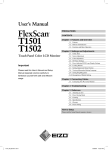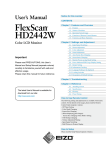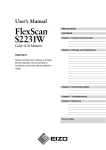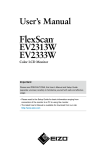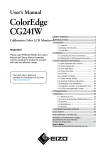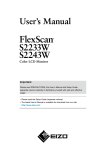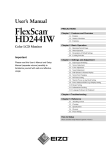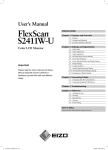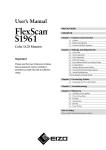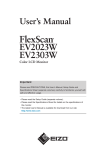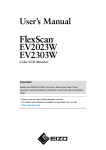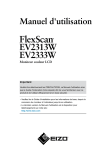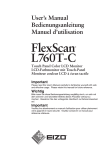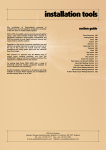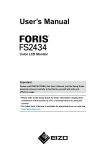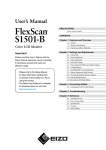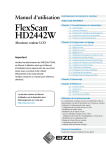Download FlexScan EV2333W User`s Manual
Transcript
Important Please read PRECAUTIONS, this User’s Manual, Setup Guide and Specifications Sheet (separate volumes) carefully to familiarize yourself with safe and effective usage. • Please read the Setup Guide (separate volume). • Please read the Specifications Sheet for details on the specifications of the monitor. • The latest User’s Manual is available for download from our site: http://www.eizo.com [Location of Caution Statement] Ex. FlexStand As an ENERGY STAR® Partner, EIZO NANAO CORPORATION has determined that this product meets the ENERGY STAR guidelines for energy efficiency. This product has acquired TCO standard that relates to safety, ergonomics, environment and so forth of office equipment.For overview of the TCO, refer to our website. http://www.eizo.com Product specification may vary with sales areas. Confirm the specification in the manual written in language of the region of purchase. Copyright© 2009 EIZO NANAO CORPORATION All rights reserved. No part of this manual may be reproduced, stored in a retrieval system, or transmitted, in any form or by any means, electronic, mechanical, or otherwise, without the prior written permission of EIZO NANAO CORPORATION. EIZO NANAO CORPORATION is under no obligation to hold any submitted material or information confidential unless prior arrangements are made pursuant to EIZO NANAO CORPORATION’s receipt of said information. Although every effort has been made to ensure that this manual provides up-to-date information, please note that EIZO monitor specifications are subject to change without notice. Apple and Macintosh are registered trademarks of Apple Inc. VGA is a registered trademark of International Business Machines Corporation. DisplayPort icon and VESA are registered trademarks or trademarks of Video Electronics Standards Association in the United States and other countries. Windows and Windows Vista are registered trademarks of Microsoft Corporation in the United States and other countries. EIZO, FlexScan and ScreenManager are registered trademarks of EIZO NANAO CORPORATION in Japan and other countries. Notice for this monitor This product is suited to creating documents, viewing multimedia content, and other general purposes. This product has been adjusted specifically for use in the region to which it was originally shipped. If the product is used outside the region, it may not operate as specified in the specifications. This product may not be covered by warranty for uses other than those described in this manual. The specifications noted in this manual are only applicable for power cords and signal cables specified by us. Use optional products manufactured or specified by us with this product. As it takes about 30 minutes for the performance of electrical parts to stabilize, adjust the monitor 30 minutes or more after the monitor power has been turned on. In order to suppress the luminosity change by long-term use and to maintain the stable luminosity, use of a monitor in lower brightness is recommended. When the screen image is changed after displaying the same image for extended periods of time, an afterimage may appear. Use the screen saver or timer to avoid displaying the same image for extended periods of time. Periodic cleaning is recommended to keep the monitor looking new and to prolong its operation lifetime. (Refer to “Cleaning” on the next page.) The LCD panel is manufactured using high-precision technology. However, missing pixels or lit pixels may appear on the LCD panel, this is not malfunction. Percentage of effective pixels : 99.9994% or higher. The backlight of the LCD panel has a fixed life span. When the screen becomes dark or begins to flicker, please contact your dealer. Do not press on the panel or edge of the frame strongly, as this may result in the display malfunction, such as the interference patterns, etc. If pressure is continually applied to the LCD panel, it may deteriorate or damage your LCD panel. (If the pressure marks remain on the LCD panel, leave the monitor with a white or black screen. The symptom may disappear.) Do not scratch or press on the panel with any sharp objects, such as a pencil or pen as this may result in damage to the panel. Do not attempt to brush with tissues as this may scratch the LCD panel. When the monitor is cold and brought into a room or the room temperature goes up quickly, dew condensation may occur inside and outside the monitor. In that case, do not turn the monitor on and wait until dew condensation disappears, otherwise it may cause some damages to the monitor. Cleaning Attention • Never use any solvents or chemicals, such as thinner, benzene, wax, alcohol, and abrasive cleaner, which may damage the cabinet or LCD panel. NOTE • Optional ScreenCleaner is recommended for cleaning the panel surface. [LCD Panel] • Clean the LCD panel with a soft cloth such as cotton cloth or lens cleaning paper. • Remove persistent stains gently with a cloth dampened with a little water, and then clean the LCD panel again with a dry cloth for better finishing. [Cabinet] Clean the cabinet with a soft cloth dampened with a little mild detergent. To use the monitor comfortably • An excessively dark or bright screen may affect your eyes. Adjust the brightness of the monitor according to the environmental conditions. • Staring at the monitor for a long time tires your eyes. Take a 10-minute rest every hour. CONTENTS Notice for this monitor............................................... 3 CONTENTS.............................................................. 5 2-10 Shifting to the power saving mode when a person leaves the monitor [EcoView Sense]............................................. 24 ● To set EcoView Sense On/Off........................... 24 Chapter 1 Features and Overview...................... 7 ● To change the detection level............................ 24 1-1 Features............................................................. 7 2-11 Setting On/Off for the power saving level indicator [EcoView Index].............................. 25 1-2 Controls and Functions................................... 9 2-12 Screen Size Selection..................................... 25 1-3 Functions and Basic Operation..................... 10 ● To change screen size [Screen Size]................ 25 Chapter 2 Settings and Adjustments............... 14 [Border Intensity]............................................... 26 2-1 Utility Disk....................................................... 14 ● Disk contents and software overview................ 14 ● To use ScreenManager Pro for LCD................. 14 2-2 Screen Adjustment......................................... 15 Digital Input........................................................... 15 Analog Input......................................................... 15 2-3 Color Adjustment............................................ 18 ● To select the display mode (FineContrast mode)......................................... 18 ● To perform advanced adjustments.................... 19 ● Adjustment items in each mode........................ 19 ● To adjust the brightness [Brightness]................ 19 ● To adjust brightness of non-display area 2-13 Setting Adjustment Menu Display................. 26 ● To update menu settings [Menu Size/Menu Position/Menu Off Timer/ Translucent]....................................................... 26 2-14 Setting Orientation......................................... 27 ● To set the orientation of the Adjustment menu [Orientation]....................................................... 27 2-15 Locking Buttons............................................. 27 2-16 Displaying Monitor Infomation [Information].................................................... 28 2-17 Enabling/Disabling DDC/CI communication.................................. 28 ● To adjust the contrast [Contrast]........................ 20 ● To adjust the color temperature [Temperature].................................................... 20 ● To adjust the gamma value [Gamma]................ 20 2-18 Setting Power Indicator ON/OFF [Power Indicator]............................................ 28 2-19 Setting Language [Language]....................... 28 ● To adjust the color saturation [Saturation]......... 21 ● To adjust the hue [Hue]..................................... 21 2-20 Setting EIZO logo display ON/OFF................ 29 ● To adjust the gain value [Gain].......................... 21 ● To set the Overdrive intensity [Overdrive]......... 21 2-21 Resuming the Default Setting [Reset].......... 29 2-4 Adjusting Volume [Volume]........................... 22 ● To reset color adjustment values....................... 29 ● To reset all adjustments to the factory default settings.............................................................. 29 2-5 Switching sound source during DisplayPort signal input [Source]...................................... 22 2-6 Turning off the audio output at Power Saving mode [Power Save]......................................... 22 2-7 Setting On/Off for Power Saving mode [Power Save]................................................... 22 2-8 Turning off the monitor automatically [Off Timer]....................................................... 23 Chapter 3 Connecting Cables........................... 30 3-1 Connecting More than Two PCs to the Monitor...................................................... 30 ● To switch the input signal.................................. 31 ● To set input signal selection [Input Signal]........ 31 Chapter 4 Troubleshooting................................ 32 2-9 Setting On/Off for the automatic brightness adjustment function [Auto EcoView]............ 23 CONTENTS CONTENTS Chapter 5 Reference.......................................... 35 5-1 Attaching an Arm............................................ 35 5-2 Attaching the FlexStand................................. 37 5-3 Attaching the TriStand................................... 38 5-4 Folding the TriStand....................................... 39 5-5 Glossary.......................................................... 41 5-6 Preset Timing.................................................. 43 FCC Declaration of Conformity........................... 44 Hinweise zur Auswahl des richtigen Schwenkarms für Ihren Monitor.......................... 45 Hinweis zur Ergonomie........................................ 45 CONTENTS Chapter 1 Features and Overview Thank you very much for choosing an EIZO color LCD monitor. 1-1 Features • 23” wide format LCD • Applicable to the resolution of 1920 × 1080 • Power saving function Suppressing the power consumption*1 reduces the carbon dioxide emissions. This product is equipped with various power saving functions. – Power Consumption when main power switch is Off: 0W Equipped with main power switch. Turning off the main power switch completely shuts off power supply to the monitor while the monitor is not used. – Standby power: 0.1W or less Standby power when Power button is Off: 0.1W or less. – Auto EcoView function The sensor on the front side of the monitor detects the environmental brightness to adjust the screen brightness automatically and comfortably. Excessively high brightness may lead a damage to the natural environment as well as to your eyes. Suppressing the excessively high brightness will be helpful to reduce the power consumption and the damage to your eyes. 2-9 “Setting On/Off for the automatic brightness adjustment function [Auto EcoView]” (page 23) – EcoView Sense function The sensor on the front side of the monitor detects the movement of a person. When a person moves away from the monitor, it shifts to the power saving mode automatically and does not display the images on the screen. Therefore, the function reduces the power consumption. 2-10 “Shifting to the power saving mode when a person leaves the monitor [EcoView Sense]” (page 24) – EcoView Index function The green indicator shows the power consumption ratio responding to the brightness of the monitor. You can realize the power consumption reduction by taking consideration in the ratio of power saving. 2-11 “Setting On/Off for the power saving level indicator [EcoView Index]” (page 25) • FineContrast function 2-3 “To select the display mode (FineContrast mode)” (page 18) • Applicable to DisplayPort (applicable to 8 bit)*2 The image signal and audio signal can both be transmitted via a single DisplayPort cable (option). • Portrait/Landscape display available • The software “ScreenManager Pro for LCD (DDC/CI)” to adjust the screen using the mouse and keyboard is included 2-1 “Utility Disk” (page 14) • HDCP (High-bandwidth Digital Content Interface) • Built-in speakers and headphone jack 1-2 “Controls and Functions” (page 9) • Overdrive function 2-3 “To set the Overdrive intensity [Overdrive]” (page 21) *1 Reference values: Maximum power consumption: 42W (Luminance Max., at default settings) Standard power consumption: 25W (100VAC, Luminance 120cd/m2, at default settings) Standard power consumption: 24W (200VAC, Luminance 120cd/m2, at default settings) *2 When transmitting an audio signal using the DisplayPort cable, the graphics board must be compatible with audio output. (“Specifications List” in Specifications Sheet) Chapter 1 Features and Overview NOTE • This monitor supports the Portrait/Landscape display. This function allows you to change the orientation of the Adjustment menu when using the monitor screen in vertical display position. (Refer to “To set the orientation of the Adjustment menu [Orientation]” on page 27.) • For using the monitor with “Portrait” position, the graphics board supporting portrait display is required. When using the monitor with “Portrait” position, the setting needs to be changed depending on the graphics board used in your PC. Refer to the manual of the graphics board for details. • The stand of the unit can be replaced with an arm or another stand. (Refer to “5-1 Attaching an Arm” on page 35.) Chapter 1 Features and Overview 1-2 Controls and Functions Ex. FlexStand 14 17 16 13 Adjustment menu (*ScreenManager ®) 15 1 2 3 4 5 6 1 EcoView Sense sensor 2 3 Auto EcoView sensor EcoView button 4 Input Signal Selection button 5 Enter button 6 Control buttons (Left, Down, Up, Right) 7 8 Power button Power indicator 9 10 Main Power Switch Power connector 11 Input signal connectors 12 13 14 15 16 17 Stereo mini jack Security lock slot Stand Cable holder Speaker Headphone jack 7 8 9 10 11 12 Detects the movement of a person in front of the monitor. EcoView Sense function (page 24). Detects ambient brightness. Auto EcoView function (page 23). Displays the setting menu of the power saving function (Auto EcoView, EcoView Sense and EcoView Index) (page 23, 24, 25). Switches input signals for display when more than two PCs are connected to the monitor (page 31). Displays the Adjustment menu, determines an item on the menu screen, and saves values adjusted (page 13). •Chooses an adjustment item or increases/decreases adjusted values for advanced adjustments using the Adjustment menu (page 13). • or button: Switches the display mode (page 18). • or button: Displays the adjustment menu of the brightness and volume (page 10). Turns the power on or off. Indicates monitor’s operation status. Blue: Operating Orange: Power saving Off: Power off Turns the main power on or off. Connects the power connector. Left : DisplayPort Connector / Center : DVI-D Connector / Right : D-Sub mini 15-pin connector Connects the stereo mini jack cable. Complies with Kensington’s MicroSaver security system. Used to adjust the height and angle of the monitor screen. Covers the monitor cables. Outputs audio source. Connects the headphones. * ScreenManager ® is an EIZO’s nickname of the Adjustment menu. See page 10 for how to use. Chapter 1 Features and Overview 1-3 Functions and Basic Operation To adjust the screen and color Main menu (Refer to page 13 for operation) Analog input only [At analog signal input] 1 [At digital signal input] ● To adjust flickering and position [Screen]………………………………… see page 15 ● To adjust color gradation automatically [Range]………………………………… see page 17 2 Screen Adjustment (Automatic Adjustment) Screen Adjustment (Advanced Adjustment) [At analog signal input] Page 15 Page 16 [At digital signal input] • The Adjustment menu and the FineContrast mode name cannot be displayed at the same time. FineContrast mode Page 18 Color Adjustment Simple Adjustment [FineContrast mode] This function allows easy selection of a desired mode from five modes according to monitor application. ● To eliminate vertical bars [Clock*]…… see page 16 ● To remove flickering or blurring [Phase*]………………………………… see page 16 ● To correct screen position [Position*] ……………………………… see page 17 ● To modify blurred characters/lines [Smoothing]… ………………………… see page 17 * Brightness and volume direct menu Items marked with * can be adjusted with analog input. Color Adjustment Advanced Adjustment Page 19 Brightness and Volume Adjustment Press or to display the adjustment menu. Brightness: Press or . Volume or . 10 : Press Chapter 1 Features and Overview ● “Brightness”, “Contrast”, “Temperature”, “Gamma”, “Saturation”, “Hue”, “Gain” and “Overdrive” can be set for each mode (Custom/ sRGB/Text/Picture/Movie). Settable functions vary with the FineContrast mode. Resuming the default settings ● To reset color adjustment values [Reset]… ……………………………… see page 29 To use the monitor with low power consumption Main menu (Refer to page 13 for operation) [At analog signal input] Power-save Settings ● Setting On/Off for Power Saving mode [Power Save] … ………………………see page 22 ● Turning off the monitor automatically [Off Timer] … …………………………see page 23 ● Shifting to the power saving mode when a person leaves the monitor [EcoView Sense]………………………see page 24 [At digital signal input] • The Adjustment menu and the EcoView menu cannot be displayed at the same time. • EcoView menu is temporarily displayed when the power of the monitor is turned on. EcoView menu Setting On/Off for the EcoView function (power saving function) Page 23 This monitor is equipped with the EcoView function for power saving. Press to display the setting menu. Choose the item with or with ). Change "On" and "Off" with (you can also choose it or . ● Setting On/Off for the automatic brightness adjustment function [Auto EcoView] … …………………………see page 23 ● Shifting to the power saving mode when a person leaves the monitor [EcoView Sense] … ………………………see page 24 ● Setting On/Off for the power saving level indicator [EcoView Index] ……………………………see page 25 Chapter 1 Features and Overview 11 To make useful settings/adjustments Adjustment menu (Refer to page 13 for operation) [At analog signal input] Other Settings ● To set input signal selection [Input Signal]… ……………………… see page 31 ● To change screen size [Screen Size]… ……………………… see page 25 ● To adjust brightness of non-display area [Border Intensity]……………………… see page 26 ● To update menu settings [Menu Size/Menu Position/Menu Off Timer/ Translucent]…………………………… see page 26 ● To set the orientation of the Adjustment menu [Orientation]…………………………… see page 27 ● Setting Power Indicator ON/OFF [Power Indicator]……………………… see page 28 ● To reset all adjustments to the factory default settings [Reset]… …………………… see page 29 [At digital signal input] Information Page 28 Sound Settings [At D-Sub/DVI-D signal input] [At DisplayPort signal input] ● Displaying Monitor Infomation [Information] Language Page 28 ● Adjusting Volume [Volume]…………… see page 22 ● Switching sound source during DisplayPort signal input [Source*]………………… see page 22 ● Turning off the audio output at Power Saving mode [Power Save]…………………… see page 22 * ● Setting Language [Language] ● Locking Buttons… ……………………… see page 27 ● Enabling/Disabling DDC/CI communication … ………………………………………… see page 28 ● Setting EIZO logo display ON/OFF… … see page 29 12 Chapter 1 Features and Overview An item marked with * can be adjusted with DisplayPort input. Basic operation of Adjustment menu [Displaying Adjustment menu and selecting function] . The Main menu appears. (1) Press (2) Select a function with / / / , and press . The Sub menu appears. (3) Select a function with / / / , and press . The adjustment/setting menu appears. (4) Adjust the selected item with / / / , and press . The setting is saved. [Exiting Adjustment menu] (1) Choose <Return> from the Sub menu and press (2) Choose <Exit> from the Main menu and press . The Main menu appears. . The Adjustment menu quits. NOTE • The Adjustment menu can also be exited by pressing • <Exit> or <Return> can also be selected by pressing twice quickly. twice in the Main menu or Sub menu. Chapter 1 Features and Overview 13 Chapter 2 Settings and Adjustments 2-1 Utility Disk An “EIZO LCD Utility Disk” (CD-ROM) is supplied with the monitor. The following table shows the disk contents and the overview of the software programs. ● Disk contents and software overview The disk includes software programs for adjustment, and User's Manual. Refer to “Readme.txt” or the “read me” file on the disk for software startup procedures or file access procedures. Item Overview OS A “Readme.txt” or “read me” file Screen adjustment pattern files Used when adjusting the image of the analog signal input manually. Windows * If your OS is other than Windows, download the pattern files from our site: http://www.eizo.com ScreenManager Pro for LCD (DDC/CI) A software for adjusting the screen using Windows Vista the mouse and keyboard. EIZO ScreenSlicer A software that divides a screen and lays out multiple windows efficiently. Windows XP/Vista User’s Manual of this monitor (PDF file) ● To use ScreenManager Pro for LCD For the installation and use of ScreenManager Pro for LCD, refer to its User’s Manual on the disk. 14 Chapter 2 Settings and Adjustments 2-2 Screen Adjustment Digital Input When digital signals are input, images are displayed correctly based on the preset data of the monitor, but if characters and/or lines appear blurred, go to step 6 “To modify blurred characters/lines [Smoothing]”. When performing more advanced adjustment, see “2-3 Color Adjustment” (page 18) and subsequent pages. Analog Input Attention The monitor screen adjustment is used to suppress flickering of the screen or adjust screen position and screen size correctly according to the PC to be used. The auto adjust function works in the following cases: • When a signal is input into the monitor for the first time • When the resolution or Vertical/Horizontal Frequency not displayed before is set If the screen is not displayed correctly even after performing the auto adjustment, perform the screen adjustments according to the procedures on the following pages to use the monitor comfortably. • Wait 30 minutes or more from monitor power on before starting adjustments. It is recommended to turn off the EcoView Sense to prevent the monitor from shifting to the power saving mode in this period (Refer to "2-10 Shifting to the power saving mode when a person leaves the monitor [EcoView Sense]" on page 24). • Auto adjust function does not work for the images under the resolution of 800 × 600 (SVGA). [Adjustment Procedure] 1 Perform the auto adjustment. Attention ● To adjust flickering, screen position, and screen size automatically [Screen] (1) Choose <Screen> from the <Auto Adjustment> menu, and press . The <Auto Adjustment> menu appears. (2) Choose <Execute> with or , and press . Flickering, screen position, and screen size are corrected by the autoadjustment function. • This function works correctly when an image is fully displayed over the Windows or Macintosh display area. It does not work properly when an image is displayed only on a part of the screen (command prompt window, for example) or when a black background (wallpaper, etc.) is in use. • This function does not work correctly with some graphics boards. If the screen is not displayed correctly even after adjusting in step 1 above, perform the adjustments according to the procedures on the following pages. When the screen is displayed correctly, go to step 5 “To adjust color gradation automatically [Range]”. 2 Prepare the display pattern for the analog display adjustment. ■ For Windows PC Load the “EIZO LCD Utility Disk” to your PC, and then open the screen adjustment pattern files. ■ For other than Windows PC Download the "Screen adjustment pattern files" from our site: http://www.eizo.com NOTE • For how to open and contents of the screen adjustment pattern files, refer to “Readme.txt”. Chapter 2 Settings and Adjustments 15 the auto adjustment again with the analog screen 3 Perform adjustment pattern displayed. ● To adjust flickering, screen position, and screen size automatically [Screen] (1) Display Pattern 1 of the screen adjustment pattern files in full screen on the monitor. (2) Choose <Screen> from the <Auto Adjustment> menu, and press . The <Auto Adjustment> menu appears. (3) Choose <Execute> with or . , and press Flickering, screen position, and screen size are corrected by the autoadjustment function. If the screen is not displayed correctly even after adjusting in step 3 above, perform the adjustments according to the procedures on the following pages. When the screen is displayed correctly, go to step 5 “To adjust color gradation automatically [Range]”. advanced adjustments for the following using the 4 Perform <Screen> menu of the Adjustment menu. Adjust the clock, phase and position, in this order. ● To eliminate vertical bars [Clock] (1) Choose <Clock> from the <Screen> menu, and press NOTE . The <Clock> menu appears. (2) Adjust the clock with or , and press . The adjustment is completed. ● To remove flickering or blurring [Phase] Adjustable range: 0 to 63 (1) Choose <Phase> from the <Screen> menu, and press The <Phase> menu appears. (2) Adjust the phase with or , and press • Press the control button slowly so as not to miss the adjustment point. • When blurring, flickering or bars appear on the screen after adjustment, proceed to [Phase] to remove flickering or blurring. Attention . • Flickering or blurring may not be eliminated depending on your PC or graphics board. . The adjustment is completed. NOTE • When vertical bars appear on the screen after adjustment, go back to “To eliminate vertical bars [Clock]”. (Clock → Phase → Position) 16 Chapter 2 Settings and Adjustments ● To correct screen position [Position] (1) Choose <Position> from the <Screen> menu, and press NOTE . The <Position> menu appears. (2) Adjust the position with / / / to display the image properly in the display area of the monitor, and press The adjustment is completed. • Since the number of pixels and the pixel positions are fixed on the LCD monitor, only one position is provided to display images correctly. The position adjustment is made to shift an image to the correct position. 5 Adjust the color gradation. ● To adjust color gradation automatically [Range] Every color gradation (0 to 255) can be displayed by adjusting the signal output level. (1) Display Pattern 2 of the screen adjustment pattern files in full screen on the monitor. (2) Choose <Range> from the <Auto Adjustment> menu, and press . (3) Choose “Execute” with or , and press . The output range is adjusted automatically. (4) Close the Pattern 2. 6 Modify blurred characters or lines. ● To modify blurred characters/lines [Smoothing] When a image is displayed with a resolution other than the recommendation, the characters or lines of the displayed image may be blurred. Adjustable range: 1 to 5 (1) Choose <Screen> from the Adjustment menu, and press . (2) Choose <Smoothing> from the <Screen> menu, and press . Attention • Smoothing setting may not be required depending on the display resolution. (You cannot choose the smoothing icon.) The <Smoothing> menu appears. (3) Adjust the characters/lines with or , and press . The adjustment is completed. Chapter 2 Settings and Adjustments 17 2-3 Color Adjustment ● To select the display mode (FineContrast mode) FineContrast allows you to select the best display mode easily according to the monitor’s application. FineContrast mode Mode Purpose Custom Available to change all setting values. sRGB Suitable for color matching with sRGB compatible peripherals. Text Suitable for displaying texts for word processing or spreadsheets. Picture Suitable for displaying images such as photos or picture images. Movie Suitable for playing back animated images. Displays the current mode. (1) Press or . NOTE The FineContrast mode name appears at the lower left of the screen. (2) Change the mode by pressing or while mode name is displayed. →Custom←→sRGB←→Text←→Picture←→Movie← 18 Chapter 2 Settings and Adjustments • The Adjustment menu and the FineContrast mode name cannot be displayed at the same time. • “ScreenManager Pro for LCD” allows you to select the FineContrast mode automatically according to the application used. (Refer to “Chapter 3 Auto FineContrast” on the User’s Manual for “ScreenManager Pro for LCD”.) ● To perform advanced adjustments Attention Independent setting and saving of color adjustment are available for each FineContrast mode. ● Adjustment items in each mode According to the FineContrast mode selected, the adjustable function differs. √ : Adjustment available −: Invalid for adjustment Icon Function FineContrast mode Custom sRGB Text Picture Movie Brightness √ √ √ √ √ Contrast √ √ √ √ Temperature √ √ √ √ Gamma √ √ − − Saturation √ √ √ √ Hue √ √ √ √ Gain √ Overdrive √ − − − − − − − − − − − − − Reset √ √ √ √ √ ● To adjust the brightness [Brightness] • Wait 30 minutes or more from monitor power on before starting adjustments. It is recommended to turn off the EcoView Sense to prevent the monitor from shifting to the power saving mode in this period (Refer to "2-10 Shifting to the power saving mode when a person leaves the monitor [EcoView Sense]" on page 24). • Perform the range adjustment first when adjusting color for analog input signals. (Refer to “To adjust color gradation automatically” on page 17). • The same image may be seen in different colors on multiple monitors due to their monitor-specific characteristics. Make fine color adjustment visually when matching colors on multiple monitors. NOTE • The values shown in “%” or “K” are available only as reference. • Using the “ScreenManager Pro for LCD” allows you to perform the color adjustment by using the mouse and keyboard of your PC. The adjusted status can be registered as a color data and restore the data later. (Refer to “Chapter 4 Color Adjustment” on the User’s Manual for “ScreenManager Pro for LCD”.) NOTE The screen brightness is adjusted by changing the brightness of the backlight (Light source from the LCD back panel). Adjustable range: 0 to 100% • You can also adjust the brightness by using the direct menu (Refer to "1-3 Functions and Basic Operation" on page 10). . (1) Choose <Color> from the Adjustment menu, and press (2) Choose <Brightness> from the <Color> menu, and press . The <Brightness> adjustment menu appears. (3) Adjust the brightness with or , and press . The adjustment is completed. Chapter 2 Settings and Adjustments 19 ● To adjust the contrast [Contrast] NOTE The luminance of the screen is adjusted by varying the video signal level. Adjustable range: 0 to 100% (1) Choose <Color> from the Adjustment menu, and press (2) Choose <Contrast> from the <Color> menu, and press . . The <Contrast> adjustment menu appears. (3) Adjust the contrast with or , and press . The adjustment is completed. ● To adjust the color temperature [Temperature] • In the contrast of 50%, every color gradation is displayed. • When adjusting the monitor, it is recommended to perform the brightness adjustment which may not lose the gradation characteristics, prior to the contrast adjustment. Perform the contrast adjustment in the following cases. –When you feel the image is dark even if the brightness is set to 100%. (Set the contrast to higher than 50%). –When you feel the image is bright even if the brightness is set to 0%. (Set the contrast to lower than 50%). NOTE The color temperature can be adjusted. The color temperature is normally used to express the hue of “White” and/or “Black” by a numerical value. The value is expressed in degrees “K” (Kelvin). In the same way as the flame temperature, the image on the monitor is displayed reddish if the color temperature is low and is bluish if the color temperature is high. The gain preset values are set for each color temperature setting value. 5000K The white color image is displayed reddish. The 5000K or 6000K is usually used in the printing industry. 6500K The white color image is displayed in warm white like paper white. The temperature is suitable to display photographs or video images. 9300K The white color image is displayed slightly bluish white. • You cannot adjust the value if the icon is not displayed, depending on the FineContrast mode selected. (See “Adjustment items in each mode” on page 19.) • [Gain] allows you to perform more advanced adjustment (See “To adjust the gain value” on page 21). • If you set to [Off], the image is displayed in the preset color of the monitor (Gain: 100% for each RGB). • When changing the gain value, the color temperature adjusting range is changed to “Off”. Adjustable range: Off, 4000K-10000K (specified by every 500K unit, including 9300K) (1) Choose <Color> from the Adjustment menu, and press . (2) Choose <Temperature> from the <Color> menu, and press . The <Temperature> adjustment menu appears. (3) Adjust the color temperature with or . , and press The adjustment is completed. ● To adjust the gamma value [Gamma] NOTE The gamma value can be adjusted. The luminance of the monitor varies depending on the input signal, however, the variation rate is not proportional to the input signal. To keep the balance between the input signal and the luminance of the monitor is called as “Gamma correction”. Adjustable range: 1.8, 2.0, 2.2 (1) Choose <Color> from the Adjustment menu, and press (2) Choose <Gamma> from the <Color> menu, and press The <Gamma> adjustment menu appears. (3) Adjust the gamma value with or The adjustment is completed. 20 Chapter 2 Settings and Adjustments , and press . . . • You cannot adjust the value if the icon is not displayed, depending on the FineContrast mode selected. (See “Adjustment items in each mode” on page 19.) ● To adjust the color saturation [Saturation] Attention • This function does not enable to display every color gradation. This function allows you to adjust the saturation of the color on the monitor. Adjustable range: -128 to 127 NOTE • You cannot adjust the value if the icon is not displayed, depending on the FineContrast mode selected. (See “Adjustment items in each mode” on page 19.) • Setting the minimum (-128) turns the image to a monochrome screen. (1) Choose <Color> from the Adjustment menu, and press . (2) Choose <Saturation> from the <Color> menu, and press . The <Saturation> adjustment menu appears. (3) Adjust the saturation of the color with or . , and press The adjustment is completed. ● To adjust the hue [Hue] Attention • This function does not enable to display every color gradation. This function allows you to adjust the hue. If you set the hue to a high value, the image turns greenish. If low, the image turns purplish. Adjustable range: -32 to 32 (1) Choose <Color> from the Adjustment menu, and press (2) Choose <Hue> from the <Color> menu, and press . NOTE • You cannot adjust the value if the icon is not displayed, depending on the FineContrast mode selected. (See “Adjustment items in each mode” on page 19.) . The <Hue> adjustment menu appears. (3) Adjust the hue with or , and press . The adjustment is completed. ● To adjust the gain value [Gain] Attention Each luminance of red/green/blue composing the color is called “Gain”. The gain adjustment may change the color tone of the “White” (when the max input signal for each color is obtained) Adjustable range: 0 to 100% (1) Choose <Color> from the Adjustment menu, and press (2) Choose <Gain> from the <Color> menu, and press . . The <Gain> adjustment menu appears. (3) Adjust the respective value of Red, Green or Blue with . or , and press The adjustment is completed. ● To set the Overdrive intensity [Overdrive] Attention (1) Choose <Color> from the Adjustment menu, and press (2) Choose <Overdrive> from the <Color> menu, and press . . NOTE The <Overdrive> setting menu appears. The setting is completed. NOTE • You cannot adjust the value if the icon is not displayed, depending on the FineContrast mode selected. (See “Adjustment items in each mode” on page 19.) • The gain value may change depending on the value of the color temperature. • When changing the gain value, the color temperature adjusting range is changed to “Off”. • Overdrive function is disabled in the following case: –Vertical frequency of input signal is not 60Hz. –Select [Normal] during <Screen Size>.(excluding the case that display resolution is 1920 x 1080) This function allows you to set the overdrive intensity based on the use of the monitor. Image lag sensation is reduced if [Enhanced] is set when displaying animated images. Adjustment range: Enhanced, Standard, Off (3) Select “Enhanced”, “Standard” or “Normal” with • This function does not enable to display every color gradation. or , and press . • You cannot adjust the value if the icon is not displayed, depending on the FineContrast mode selected. (See “Adjustment items in each mode” on page 19.) Chapter 2 Settings and Adjustments 21 2-4 Adjusting Volume [Volume] NOTE • You can also adjust the brightness by using the direct menu (Refer to "1-3 Functions and Basic Operation" on page 10). • The volume for the DisplayPort and the stereo mini jack can be set individually. This function allows you to adjust volume up or down. Adjustable range: 0 to 30 (1) Choose <Sound> from the Adjustment menu, and press (2) Choose <Volume> from the <Sound> menu, and press . . The volume adjustment menu appears. (3) Adjust the volume with or , and press . The adjustment is completed. NOTE 2-5 Switching sound source during DisplayPort signal input [Source] • This function is available with DisplayPort input. This function allows you to switch sound source during DisplayPort signal input. You can select the DisplayPort or Stereo Mini Jack. (1) Choose <Sound> from the Adjustment menu, and press . (2) Choose <Source> from the <Sound> menu, and press . The Source adjustment menu appears. (3) Select “DisplayPort” or “Stereo Mini Jack” with or . , and press The setting is completed. 2-6 Turning off the audio output at Power Saving mode [Power Save] This monitor allows you to turn off the audio output from the speakers/ headphone at the power saving mode. (1) Choose <Sound> from the Adjustment menu, and press . (2) Choose <Power Save> from the <Sound> menu, and press . The <Power Save> setting menu appears. (3) Select “On” or “Off” with or , and press . The setting is completed. 2-7 Setting On/Off for Power Saving mode [Power Save] This function allows you to set the monitor into the power saving mode according to the PC status. When the monitor has shifted to the power saving mode, the images on the screen are not displayed. (1) Choose <PowerManager> from the Adjustment menu, and press . (2) Choose <Power Save> from the <PowerManager> menu, and press The <Power Save> setting menu appears. (3) Select “On” or “Off” with or , and press The setting is completed. 22 Chapter 2 Settings and Adjustments . . NOTE • No audio is output while the monitor is in the Power Saving mode, if input signal and sound source are of DisplayPort. ■Analog input Attention This monitor complies with the VESA DPMS standard. • Turning off the main power switch or unplugging the power cord completely shuts off power supply to the monitor. • Power consumption varies even when the stereo mini jack cable is connected. [Power Saving System] PC Operating Power saving Power Indicator Monitor STAND-BY SUSPENDED OFF Operating Blue Power saving Orange ■Digital input • DVI This monitor complies with the DVI DMPM standard. • DisplayPort This monitor complies with the DisplayPort Standard V1.1a. [Power Saving System] The monitor enters the power saving mode in five seconds in connection with the PC setting. PC Operating Power saving Monitor Operating Power saving Power Indicator Blue Orange 2-8 Turning off the monitor automatically [Off Timer] This function allows you to switch the setting to turn off the monitor automatically after a specified time has passed at the power saving mode. Adjustable range: Disable, Enable (0, 1, 2, 3, 5, 10, 15, 20, 25, 30, 45 min, 1-5h) (1) Choose <PowerManager> from the Adjustment menu, and press . (2) Choose <Off Timer> from the <PowerManager> menu, and press . The <Off Timer> setting menu appears. (3) Select “Enable” or “Disable” with or . When selecting “Enable”, set a monitor Off time with (4) Press . or . The setting is completed. NOTE 2-9 Setting On/Off for the automatic brightness adjustment function [Auto EcoView] • Be careful not to block the sensor on the lower side of the monitor when using the Auto EcoView function. The sensor on the front side of the monitor detects the environmental brightness to adjust the screen brightness automatically and comfortably by using the Auto EcoView function. (1) Press . The <EcoView> setting menu appears. (2) Choose "Auto EcoView" with or . (You can also choose it with (3) Select “On” or “Off” with or , and press . .) Chapter 2 Settings and Adjustments 23 2-10 Shifting to the power saving mode when a person leaves the monitor [EcoView Sense] The sensor on the front side of the monitor detects the movement of a person by using the EcoView Sense function. When a person moves away from the monitor, it shifts to the power saving mode automatically and does not display the images on the screen to reduce the power consumption. When a person comes near the monitor again, it comes back from the power saving mode and displays the images. The detection level of the EcoView Sense sensor can be changed according to the environment of usage. ● To set EcoView Sense On/Off (1) Press . The <EcoView> setting menu appears. (2) Choose "EcoView Sense" with (3) Select “On” or “Off” with or or . (You can also choose it with , and press . .) ● To change the detection level The default setting is "Auto". If the monitor does not shift to the power saving mode as you intended, change the detection level according to the following procedure. Adjustable range: see below list Level Detectable Range Details The detectable range is defined by the Auto Automatic setting person's movement. When you get out (default setting) (120 cm or less) of the range, the monitor shifts to the power saving mode. Since the function determines whether the object is moving Automatic setting or not, the monitor can shift to the power Manual1 saving mode even if there is a chair or wall (90 cm or less) in the detectable range. Manual2 120 cm or less Manual3 90 cm or less When you get out of the detectable range, the monitor shifts to the power saving mode. This setting is recommended if the monitor frequently shifts to the power saving mode when the level is "Auto" or "Manual1" even though you are in front of the monitor. (1) Choose <PowerManager> from the Adjustment menu, and press . (2) Choose <EcoView Sense> from the <PowerManager> menu, and press . The <EcoView Sense> setting menu appears. (3) Select "Auto" or "Manual" with or . When selecting "Manual", select 1, 2 or 3 for the detection level of the sensor with or . (4) Press . The setting is completed. 24 Chapter 2 Settings and Adjustments NOTE • At the time of shifting to Power Saving mode, the icon that indicates shifting is displayed. 2-11 Setting On/Off for the power saving level indicator [EcoView Index] By using the EcoView Index function, the indicator that shows the level of power saving appears at the time of turning on the monitor, adjusting the brightness or switching the FineContrast mode. The power saving ratio comes to high as the indicator level meter lights towards right. . (1) Press The <EcoView> setting menu appears. (2) Choose "EcoView Index" with (3) Select “On” or “Off” with or or . (You can also choose it with , and press . .) Attention 2-12 Screen Size Selection ● To change screen size [Screen Size] The image with the resolution other than the recommended resolution is displayed in full screen automatically. You can change the screen size by using <Screen Size> from <Others> menu. Menu • Selecting [Enlarged] or [Normal] does not enable to display every color gradation. Function Full Screen (default setting) Displays an image in full screen. Images are distorted in some cases because the vertical rate is not equal to the horizontal rate. Enlarged Displays an image in full screen. In some cases, a blank horizontal or vertical border appears to equalize the vertical rate and the horizontal rate. Normal Displays images with the specified resolution. Example: Image size 1024 × 768 Full Screen (Default setting) Enlarged (1920 × 1080) (1200 × 900) Normal (1024 × 768) (1) Choose <Others> from the Adjustment menu, and press . (2) Choose <Screen Size> from the <Others> menu, and press . The screen size setting window appears. (3) Select “Full Screen,” “Enlarged,” or “Normal” with press . or , and The screen size setting is completed. Chapter 2 Settings and Adjustments 25 ● To adjust brightness of non-display area [Border Intensity] A border (black area with no image) around the image appears in the “Normal” or “Enlarged” mode. Border (1) Choose <Others> from the Adjustment menu, and press . (2) Choose <Border Intensity> from the <Others> menu, and press . The <Border Intensity> menu appears. (3) Adjust border intensity with or , and press . The border intensity adjustment is completed. 2-13 Setting Adjustment Menu Display ● To update menu settings [Menu Size/Menu Position/Menu Off Timer/Translucent] Menu Size Change the Adjustment menu size using the following procedure. (1) Choose <Others> from the Adjustment menu, and press . (2) Choose <Menu Settings> from the <Others> menu, and press . (3) Choose <Menu Size> from the <Menu Settings> menu, and press . The <Menu Size> menu appears. (4) Select “Normal” or “Enlarged” with or , and press . The setting is completed. Menu Position Adjust the menu position using the following procedure. (1) Choose <Others> from the Adjustment menu, and press . (2) Choose <Menu Settings> from the <Others> menu, and press . (3) Choose <Menu Position> from the <Menu Settings> menu, and press The <Menu Position> menu appears. (4) Select a menu position with or , and press The setting is completed. 26 Chapter 2 Settings and Adjustments . . Menu Off Timer Set the menu display time using the following procedure. Adjustment range: Disable, Enable (15, 30, 45, 60s) NOTE • The display time of the FineContrast mode, EcoView menu and EcoView Index remains unchanged. (1) Choose <Others> from the Adjustment menu, and press . (2) Choose <Menu Settings> from the <Others> menu, and press . (3) Choose <Menu Off Timer> from the <Menu Settings> menu, and press . The <Menu Off Timer> menu appears. (4) Select “Enable” or “Disable” with or . When selecting “Enable”, choose a time for displaying menu with . (5) Press . or The setting is completed. Translucent Set the transparency for menu display using the following procedure. (1) Choose <Others> from the Adjustment menu, and press . (2) Choose <Menu Settings> from the <Others> menu, and press . (3) Choose <Translucent> from the <Menu Settings> menu, and press . The <Translucent> menu appears. (4) Adjust the transparency for menu display with or , and press . The setting is completed. NOTE 2-14 Setting Orientation ● To set the orientation of the Adjustment menu [Orientation] This function allows you to change the orientation of the Adjustment menu when using the monitor screen in vertical display position. (1) Choose <Others> from the Adjustment menu, and press (2) Choose <Orientation> from the Others menu, and press . . The <Orientation> menu appears. (3) Select “Landscape” or “Portrait” with or , and press . • For using the monitor with “Portrait” position, the graphics board supporting portrait display is required. When using the monitor with “Portrait” position, the setting needs to be changed depending on the graphics board used in your PC. Refer to the manual of the graphics board for details. The setting is completed. (4) When selecting “Portrait”, turn the monitor screen 90° in clockwise direction. 2-15 Locking Buttons This function allows you to lock (1) Press (2) Press to prevent changing the adjusted/set status. to turn off the monitor. holding down to turn on the monitor. The Lock/Unlock setting is toggled by performing the operation in step 2. Chapter 2 Settings and Adjustments 27 2-16 Displaying Monitor Infomation [Information] NOTE This function allows you to display the input signal status, current resolution and model name. Information 1/3 : I nput signal status (analog/digital), resolution and H/V frequency Information 2/3 : E nable/Disable setting for DDC/CI Information 3/3 : M odel name, serial number and usage time (1) Choose <Information> from the Adjustment menu, and press . • The usage time is not always “0” when you purchase the monitor due to factory inspection. The <Information> menu appears. (2) Then, press to check settings, etc. NOTE 2-17 Enabling/Disabling DDC/CI communication • You can check the DDC/CI setting in the <Information> menu. This function allows you to enable/disable the DDC/CI communication. (1) Press to turn off the monitor. (2) Press holding down to turn on the monitor. The Enable/Disable setting is toggled by performing the operation in step 2. 2-18 Setting Power Indicator ON/OFF [Power Indicator] This function allows you to set the power indicator (blue) ON/OFF in the monitor ON condition. (1) Choose <Others> from the Adjustment menu, and press . (2) Choose <Power Indicator> from the <Others> menu, and press . The <Power Indicator> menu appears. (3) Select “Enable” or “Disable” with or . , and press The setting is completed. 2-19 Setting Language [Language] This function allows you to select a language for the adjustment menu or displaying message. Selectable languages English/German/French/Spanish/Italian/Swedish/Simplified Chinese/ Traditional Chinese/Japanese (1) Choose <Language> menu from the Adjustment menu, and press The <Language> menu appears. (2) Choose a language with / / / The setting is completed. 28 Chapter 2 Settings and Adjustments , and press . . 2-20 Setting EIZO logo display ON/OFF The EIZO logo appears on the display when turning on the monitor. This function allows you to display, or not, the EIZO logo. (1) Press (2) Press to turn off the monitor. holding down to turn on the monitor. The EIZO logo display setting is toggled by performing the operation in step 2. 2-21 Resuming the Default Setting [Reset] Attention There are two types of Reset. One is to reset the color adjustment only to the default settings, and the other is to reset all the settings to the default settings. • After resetting, you cannot undo the operation. ● To reset color adjustment values Only the adjustment values in the current FineContrast mode will revert to the default settings (factory settings). (1) Choose <Color> from the Adjustment menu, and press . (2) Choose <Reset> from the <Color> menu and press . The <Reset> menu appears. (3) Select <Reset> with or , and press . The color adjustment values revert to the default settings. ● To reset all adjustments to the factory default settings Reset all adjustments to the factory default settings. (1) Choose <Others> from the Adjustment menu, and press (2) Choose <Reset> from the <Others> menu, and press . . NOTE • For default settings, refer to “Main default settings (factory settings)” in Specifications Sheet. The <Reset> menu appears. (3) Select <Reset> with or , and press All setting values revert to the default settings. . Chapter 2 Settings and Adjustments 29 Chapter 3 Connecting Cables 3-1 Connecting More than Two PCs to the Monitor More than two PCs can be connected to the monitor through the D-Sub mini 15 pin, the DVI-D and the DisplayPort connector on the back of the monitor. Connection examples DisplayPort DVI-D connector connector D-Sub mini 15-pin Connector To PC 1 D-Sub mini 15-pin Connector Analog Signal cable (supplied MD-C87) To PC 2 DVI-D connector Digital(DVI) Signal cable (supplied FD-C39) To PC 3 DisplayPort connector Digital(DisplayPort) 30 Chapter 3 Connecting Cables Signal cable (PP200 option) ● To switch the input signal The input signal switches each time is pressed. When the signal is switched, the active input port name appears at the top right corner of the screen. ● To set input signal selection [Input Signal] NOTE The monitor recognizes the connector through which PC signals are input. When a PC is turned off or enters the powersaving mode, the monitor automatically displays another signal. Priority setting • When “Auto” is selected for <InputSignal>, the monitor's powersaving function works only when all PCs are in the power-saving mode. Function Auto When a PC is turned off or enters the powersaving mode, the monitor automatically displays another signal. Manual The monitor detects only the PC’s signals currently displaying automatically. Select an active input signal with . [Input signal setting] . (1) Choose <Others> from the Adjustment menu, and press (2) Choose <Input Signal> from the <Others> menu, and press . The <Input Signal> menu appears. (3) Select “Auto” or “Manual” with or , and press . The setting is completed. Chapter 3 Connecting Cables 31 Chapter 4 Troubleshooting If a problem still remains after applying the suggested remedies, contact your local dealer. • No-picture problems → See No.1 - No.2. • Imaging problems (digital input) → See No.3 - No.8. • Imaging problems (analog input) → See No.3 - No.11. • Other problems → See No.12 - No.17. Problems 1. No picture • Power indicator does not light. Possible cause and remedy • Check whether the power cord is connected correctly. If the problem persists, turn off the monitor, and then turn it on again a few minutes later. • Turn the main power switch on. • Press . • Power indicator is lighting blue. • Set each adjusting value in [Brightness], [Contrast] and [Gain] to higher level. (see page 19, 20, 21) • Power indicator is lighting orange. • • • • • Power indicator flashes orange. • There is a problem in the device that uses DisplayPort connection. Solve the problem, and turn off the main power of the monitor, and then turn it on again.Refer to the user’s manual of the device that uses DisplayPort connection for details. 2. The message below appears. . Switch the input signal with Operate the mouse or keyboard. Check whether the PC is turned on. When the EcoView Sense is on, the monitor may have shifted to the power saving mode. Come near to the monitor. This message appears when the signal is not input correctly even when the monitor functions properly. • This message appears when no signal is input. Example: • The message shown left may appear, because some PCs do not output the signal soon after power-on. • Check whether the PC is turned on. • Check whether the signal cable is connected properly. • Switch the input signal with . • The message shows that the input signal is out of the specified frequency range. (Such signal frequency is displayed in red.) Example: • Check whether the signal setting of your PC matches the resolution and the vertical frequency settings for the monitor. (see "Compatible Resolutions" of the Specifications Sheet) • Reboot the PC. • Select an appropriate display mode using the graphics board’s utility. Refer to the manual of the graphics board for details. fD:Dot Clock (Displayed only when the digital signal inputs) fH:Horizontal Frequency fV:Vertical Frequency 3. The screen is too bright or too dark. 32 Chapter 4 Troubleshooting • Adjust using [Brightness] or [Contrast]. (The LCD monitor backlight has a fixed life span. When the screen becomes dark or begins to flicker, contact your local dealer.) Problems Possible cause and remedy 4. Characters are blurred. • Check whether the signal setting of your PC matches the resolution and the vertical frequency settings for the monitor. (see "Compatible Resolutions" of the Specifications Sheet) • Adjust using [Smoothing]. (see page 17) 5. Afterimages appear. • Use a screen saver or off timer function for a long-time image display. • Afterimages are particular to LCD monitors. Avoid displaying the same image for a long time. 6. Green/red/blue/white dots or defective dots remain • This is due to LCD panel characteristics and is not a on the screen. failure. 7. Interference patterns or pressure marks remain on • Leave the monitor with a white or black screen. The the screen. symptom may disappear. 8. Noise appears on the screen. • Set [Overdrive] to [Off]. • When entering the signals of HDCP system, the normal images may not be displayed immediately. 9. Display position is incorrect. • Adjust image position so that it is displayed properly within the display area using [Position]. (see page 17) • If the problem persists, use the graphics board’s utility if available to change the display position. 10. Vertical bars appear on the screen or a part of the image is flickering. • Adjust using [Clock]. (see page 16) 11. Whole screen is flickering or blurring. • Adjust using [Phase]. (see page 16) 12. The <Smoothing> icon on the Adjustment menu <Screen> cannot be selected. • You cannot choose the smoothing icon when the screen is displayed in the following resolutions or settings. • 1920 × 1080 • Select [Normal] during <Screen Size>. 13. The adjustment menu does not appear. • Check whether the operation lock function works. (see page 27) 14. The FineContrast mode is not displayed. • Check whether the Main menu of Adjustment menu is displayed. (see page 10) 15. The auto adjust function does not work correctly. • This function does not work when digital signal is input. • This function does not work correctly with some graphics boards. 16. No audio output. • Check whether the mini jack cable is correctly connected. • Check whether volume is set to 0. • Check the setting of the PC and the audio playback software. • During DisplayPort signal input, check the [Source] setting. (see page 22) Chapter 4 Troubleshooting 33 Problems Possible cause and remedy • Check the setting environment of the monitor. 17. (When using EcoView Sense) The images remains to be displayed when you EcoView Sense may not work correctly in the following move away from the monitor. The images does not environments. reappear when you come near it. • There is something that reflects the light such as mirror or glass in front of the sensor. • The monitor is located in a place that receive direct sunlight. • There is some infrared device near the monitor. • There is some obstacle in front of the sensor. • Check whether any dirt on the sensor. Clean the sensor with a soft cloth. • Check whether you are in front of the monitor. The infrared ray is emitted vertically from the sensor to detect a person. • Check whether the off timer function is on. If it is on, the monitor turns off automatically after a specified time has passed. Therefore, the images does not reappear on the screen even though you come near to it. Press to turn on the monitor (see page 23). 34 Chapter 4 Troubleshooting Chapter 5 Reference 5-1 Attaching an Arm The stand can be removed and replaced with an arm (or another stand) to be attached to the monitor. Use an arm or stand of EIZO option. using the monitor with "Portrait" position, change the 1 When position to "Landscape". the LCD monitor on a soft cloth spread over on a stable 2 Lay surface with the panel surface facing down. Attention • When attaching an arm or stand, follow the instructions of their user’s manual. • When using another manufacturer’s arm or stand, confirm the following in advance and select one conforming to the VESA standard. Use the M4 × 12 screws supplied with this monitor. – Clearance between the screw holes: 100 mm × 100 mm –Thickness of plate: 2.6 mm –Strong enough to support weight of the monitor unit (except the stand) and attachments such as cables. • When using an arm or stand, attach it to meet the following tilt angles of the monitor. –Up 45 degrees, down 45 degrees (horizontal display, and vertical display rotated 90 degrees clockwise) • Connect the cables after attaching an arm. • Do not move the removed stand up and down. Doing so may result in injury or device damage. Chapter 5 Reference 35 3 Remove the stand. ● FlexStand Remove the stand from the monitor while releasing the lock. ● TriStand Prepare a screwdriver. Loosen the screw securing the unit and the stand with the screwdriver. 4 Attach the monitor to the arm or stand. Secure the monitor to the arm or stand using the screws specified in the user’s manual of the arm or stand. 36 Chapter 5 Reference 5-2 Attaching the FlexStand The once removed the FlexStand can be attached to the monitor again with the following procedures. 1 Put the insertion part of the stand in the slot of the monitor. At the time, use as a guide that the marks (1) on the stand match to the screw holes (2) of the monitor. Screw holes Marks 2 Attach the stand moving the monitor toward the stand. Make sure that the lock is latched with clicking sound shown in the figure below. Incorrect Correct Chapter 5 Reference 37 5-3 Attaching the TriStand The once removed the TriStand can be attached to the monitor again with the following procedures. the LCD monitor on a soft cloth spread over on a stable 1 Lay surface with the panel surface facing down. 2 Put the insertion part of the stand in the slot of the monitor. a screwdriver. Press the upper part of the stand 3 Prepare against the unit and tighten the screw with the screwdriver to fix the stand to the unit. 38 Chapter 5 Reference 5-4 Folding the TriStand Perform the following procedures to remove the stand base and fold the stand when re-packing a monitor with a TriStand. 1 Open the cable holder. the monitor to its lowest position, and insert a pin into 2 Adjust the stand. the LCD monitor on a soft cloth spread over on a stable 3 Lay surface with the panel surface facing down. 4 Open the cover of stand base. Chapter 5 Reference 39 the stand base in a counterclockwise direction while 5 Rotate holding down the protrusion, and then remove the stand base. 40 Chapter 5 Reference 5-5 Glossary Clock The analog input monitor needs to reproduce a clock of the same frequency as the dot clock of the graphics system in use, when the analog input signal is converted to a digital signal for image display. This is called clock adjustment. If the clock pulse is not set correctly, some vertical bars appear on the screen. DDC/CI (Display Data Channel/Command Interface) VESA provides the standardization for the interactive communication of the setting information, etc. between a PC and the monitor. DisplayPort VESA provides the digital interface standard for the digital display device. DisplayPort can transfer the video signal up to 16 bits for each channel of RGB, and the audio signal too. (This monitor supports the 8-bit video signal only.) DVI (Digital Visual Interface) DVI is a digital interface standard. DVI allows direct transmission of the PC’s digital data without loss. This adopts the TMDS transmission system and DVI connectors. There are two types of DVI connectors. One is a DVI-D connector for digital signal input only. The other is a DVI-I connector for both digital and analog signal inputs. DVI DMPM (DVI Digital Monitor Power Management) DVI DMPM is a digital interface power-saving function. The “Monitor ON (operating mode)” and “Active Off (power-saving mode)” are indispensable for DVI DMPM as the monitor’s power mode. Gain This is used to adjust each color parameter for red, green and blue. An LCD monitor displays the color by the light passing through the panel color filter. Red, green and blue are the three primary colors. All the colors on the screen are displayed by combining these three colors. The color tone can be changed by adjusting the light intensity (volume) passing through each color’s filter. Gamma Generally, the monitor brightness varies nonlinearly with the input signal level, which is called “Gamma Characteristic”. A small gamma value produces a low-contrast image, while a large gamma value produces a highcontrast image. HDCP (High-bandwidth Digital Contents Protection) Digital signal coding system developed to copy-protect the digital contents, such as video, music, etc. This helps to transmit the digital contents safely by coding the digital contents sent via DVI terminal on the output side and decoding them on the input side. Any digital contents cannot be reproduced if both of the equipments on the output and input sides are not applicable to HDCP system. Overdirve This technology enhances response speed by increasing the potential difference at the time of motion of liquid-crystal pixels, and it is used for liquid-crystal TV sets and others in general. It provides clear-cut three-dimensional display with little image lag, by improving response speed of the intermediate graduation range that frequently appears in moving images. Phase Phase means the sampling timing to convert the analog input signal to a digital signal. Phase adjustment is made to adjust the timing. It is recommended that phase adjustment be made after the clock is adjusted correctly. Chapter 5 Reference 41 Range Adjustment Range adjustment controls the signal output levels to display every color gradation. It is recommended that range adjustment be made before color adjustment. Resolution The LCD panel consists of numerous pixels of specified size, which are illuminated to form images. This monitor consists of 1920 horizontal pixels and 1080 vertical pixels. At a resolution of 1920 × 1080, all pixels are illuminated as a full screen (1:1). sRGB (Standard RGB) International standard for “color reproduction and color space” among peripheral devices (such as monitors, printers, digital cameras, scanners). sRGB allows Internet users to closely match colors as a simple color matching means for the Internet use. Temperature Color temperature is a method to measure the white color tone, generally indicated in degrees Kelvin. The screen becomes reddish at a low temperature, and bluish at a high temperature, like the flame temperature. 5000K: Slightly reddish white 6500K: Warm white like paper white 9300K: Slightly bluish white TMDS (Transition Minimized Differential Signaling) A signal transmission system for digital interface. VESA DPMS (Video Electronics Standards Association - Display Power Management Signaling) VESA provides the standardization of signals from PC (graphics board) for power saving of PC monitors. DPMS defines the signal status between PC and monitor. 42 Chapter 5 Reference 5-6 Preset Timing The following table shows factory preset video timing (for analog signal only). Mode Dot clock VGA 640×480@60Hz 25.2 MHz VGA TEXT 720×400@70Hz 28.3 MHz VESA 640×480@73Hz 31.5 MHz VESA 640×480@75Hz 31.5 MHz VESA 800×600@56Hz 36.0 MHz VESA 800×600@60Hz 40.0 MHz VESA 800×600@72Hz 50.0 MHz VESA 800×600@75Hz 49.5 MHz VESA 1024×768@60Hz 65.0 MHz VESA 1024×768@70Hz 75.0 MHz VESA 1024×768@75Hz 78.8 MHz VESA 1152×864@75Hz 108.0 MHz CEA-861 1280×720@60Hz 74.3 MHz VESA 1280×960@60Hz 108.0 MHz VESA 1280×1024@60Hz 108.0 MHz VESA 1280×1024@75Hz 135.0 MHz VESA CVT 1680×1050@60Hz 146.3 MHz VESA CVT RB 1680×1050@60Hz 119.0 MHz CEA-861 1920×1080@60Hz 148.5 MHz Horizontal Vertical Horizontal Vertical Horizontal Vertical Horizontal Vertical Horizontal Vertical Horizontal Vertical Horizontal Vertical Horizontal Vertical Horizontal Vertical Horizontal Vertical Horizontal Vertical Horizontal Vertical Horizontal Vertical Horizontal Vertical Horizontal Vertical Horizontal Vertical Horizontal Vertical Horizontal Vertical Horizontal Vertical Frequency Horizontal: kHz Vertical: Hz 31.47 59.94 31.47 70.09 37.86 72.81 37.50 75.00 35.16 56.25 37.88 60.32 48.08 72.19 46.88 75.00 48.36 60.00 56.48 70.07 60.02 75.03 67.50 75.00 45.00 60.00 60.00 60.00 63.98 60.02 79.98 75.03 65.29 59.95 64.67 59.89 67.50 60.00 Polarity Negative Negative Negative Positive Negative Negative Negative Negative Positive Positive Positive Positive Positive Positive Positive Positive Negative Negative Negative Negative Positive Positive Positive Positive Positive Positive Positive Positive Positive Positive Positive Positive Negative Positive Positive Negative Positive Positive Attention • Display position may be deviated depending on the PC connected, which may require screen adjustment using Adjustment menu. • If a signal other than those listed in the table is input, adjust the screen using the Adjustment menu. However, screen display may still be incorrect even after the adjustment. • When interlace signals are used, the screen cannot be displayed correctly even after screen adjustment using the Adjustment menu. Chapter 5 Reference 43 For U.S.A. , Canada, etc. (rated 100-120 Vac) Only FCC Declaration of Conformity We, the Responsible Party EIZO NANAO TECHNOLOGIES INC. 5710 Warland Drive, Cypress, CA 90630 Phone: (562) 431-5011 declare that the product Trade name: EIZO Model: FlexScan EV2333W is in conformity with Part 15 of the FCC Rules. Operation of this product is subject to the following two conditions: (1) this device may not cause harmful interference, and (2) this device must accept any interference received, including interference that may cause undesired operation. This equipment has been tested and found to comply with the limits for a Class B digital device, pursuant to Part 15 of the FCC Rules. These limits are designed to provide reasonable protection against harmful interference in a residential installation. This equipment generates, uses, and can radiate radio frequency energy and, if not installed and used in accordance with the instructions, may cause harmful interference to radio communications. However, there is no guarantee that interference will not occur in a particular installation. If this equipment does cause harmful interference to radio or television reception, which can be determined by turning the equipment off and on, the user is encouraged to try to correct the interference by one or more of the following measures. * * * * Reorient or relocate the receiving antenna. Increase the separation between the equipment and receiver. Connect the equipment into an outlet on a circuit different from that to which the receiver is connected. Consult the dealer or an experienced radio/TV technician for help. Changes or modifications not expressly approved by the party responsible for compliance could void the user’s authority to operate the equipment. Note Use the attached specified cable below or EIZO signal cable with this monitor so as to keep interference within the limits of a Class B digital device. - AC Cord - Shielded Signal Cable (enclosed) Canadian Notice This Class B digital apparatus complies with Canadian ICES-003. Cet appareil numérique de le classe B est comforme à la norme NMB-003 du Canada. 44 Hinweise zur Auswahl des richtigen Schwenkarms für Ihren Monitor Dieser Monitor ist für Bildschirmarbeitsplätze vorgesehen. Wenn nicht der zum Standardzubehör gehörige Schwenkarm verwendet wird, muss statt dessen ein geeigneter anderer Schwenkarm installiert werden. Bei der Auswahl des Schwenkarms sind die nachstehenden Hinweise zu berücksichtigen: Der Standfuß muß den nachfolgenden Anforderungen entsprechen: a)Der Standfuß muß eine ausreichende mechanische Stabilität zur Aufnahme des Gewichtes vom Bildschirmgerät und des spezifizierten Zubehörs besitzen. Das Gewicht des Bildschirmgerätes und des Zubehörs sind in der zugehörenden Bedienungsanleitung angegeben. b)Die Befestigung des Standfusses muß derart erfolgen, daß die oberste Zeile der Bildschirmanzeige nicht höher als die Augenhöhe eines Benutzers in sitzender Position ist. c)Im Fall eines stehenden Benutzers muß die Befestigung des Bildschirmgerätes derart erfolgen, daß die Höhe der Bildschirmmitte über dem Boden zwischen 135 – 150 cm beträgt. d)Der Standfuß muß die Möglichkeit zur Neigung des Bildschirmgerätes besitzen (max. vorwärts: 5°, min. nach hinten ≥ 5°). e)Der Standfuß muß die Möglichkeit zur Drehung des Bildschirmgerätes besitzen (max. ±180°). Der maximale Kraftaufwand dafür muß weniger als 100 N betragen. f)Der Standfuß muß in der Stellung verharren, in die er manuell bewegt wurde. g)Der Glanzgrad des Standfusses muß weniger als 20 Glanzeinheiten betragen (seidenmatt). h)Der Standfuß mit Bildschirmgerät muß bei einer Neigung von bis zu 10° aus der normalen aufrechten Position kippsicher sein. Hinweis zur Ergonomie : Dieser Monitor erfüllt die Anforderungen an die Ergonomie nach EK1-ITB2000 mit dem Videosignal, 1920 × 1080, Digital Eingang und mindestens 60,0 Hz Bildwiederholfrequenz, non interlaced. Weiterhin wird aus ergonomischen Gründen empfohlen, die Grundfarbe Blau nicht auf dunklem Untergrund zu verwenden (schlechte Erkennbarkeit, Augenbelastung bei zu geringem Zeichenkontrast.) Übermäßiger Schalldruck von Ohrhörern bzw. Kopfhörern kann einen Hörverlust bewirken. Eine Einstellung des Equalizers auf Maximalwerte erhöht die Ausgangsspannung am Ohrhörer- bzw. Kopfhörerausgang und damit auch den Schalldruckpegel. „Maschinenlärminformations-Verordnung 3. GPSGV: Der höchste Schalldruckpegel beträgt 70 dB(A) oder weniger gemäss EN ISO 7779“ [Begrenzung des maximalen Schalldruckpegels am Ohr] Bildschirmgeräte: Größte Ausgangsspannung 150 mV 45














































